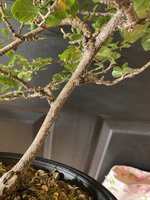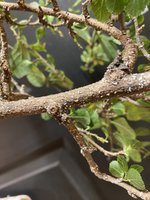MSU JBoots
Shohin
I was thinking aphids at first or mealy bugs. I treated it this spring when I noticed them with insecticidal soap twice and lightly brushed it with a toothbrush. I ignored it for awhile and they are back with a vengeance. Any insight is appreciated!


Sorry for the crappy pics but all I have is a camera on my phone.


Sorry for the crappy pics but all I have is a camera on my phone.




